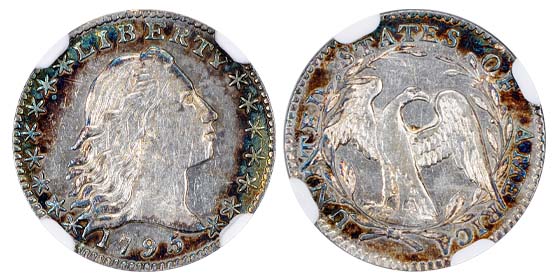Flowing Hair Half Dime Values
How Much Flowing Hair Half Dimes are Worth: Flowing Hair Half Dime Values & Coin Price Chart

Year | Mint | Variety | Designation | VG-8 | F-12 | VF-20 | EF-40 | AU-50 | U-60 | MS-63 | MS-64 | MS-65 | MS-66 | MS-67 |
|---|---|---|---|---|---|---|---|---|---|---|---|---|---|---|
1800 | P | Plain 4- Stemless Wreath | Red-brown | 200 | 300 | 400 | 500 | 600 | 700 | 800 | 900 | 1000 | 1200 | 1100 |
| Year | Mint | Variety | Designation | VG-8 | F-12 | VF-20 | EF-40 | AU-50 | MS-60 | MS-63 | MS-64 | MS-65 | MS-66 |
|---|---|---|---|---|---|---|---|---|---|---|---|---|---|
| 1794 | (None) Phil | -- | -- | $3,180.00 | $4,300.00 | $5,310.00 | $9,125.00 | $12,500.00 | $21,850.00 | $33,875.00 | $41,750.00 | $81,300.00 | $153,500.00 |
| 1795 | (None) Phil | -- | -- | $2,140.00 | $2,790.00 | $3,705.00 | $6,110.00 | $6,995.00 | $10,950.00 | $15,400.00 | $25,800.00 | $42,300.00 | $81,300.00 |
Overview
The Flowing Hair Half Dime, minted from 1794 to 1795, represents the first official U.S. half dime and one of the earliest coins struck by the United States Mint. Designed by Robert Scot, the obverse features a portrait of Liberty with flowing hair, while the reverse displays a small eagle surrounded by a wreath. Collectors highly value Flowing Hair Half Dimes for their historical significance, extreme rarity, and early American design, making them some of the most sought-after coins in U.S. numismatics.
History of the Flowing Hair Half Dime
The Flowing Hair Half Dime was introduced in 1794, making it one of the first silver coins produced by the U.S. Mint. It was part of the Coinage Act of 1792, which authorized the minting of various gold, silver, and copper denominations.
Designed by Robert Scot, the coin’s imagery was inspired by the ideals of the young American republic:
- Obverse: Liberty with long, flowing hair, symbolizing freedom.
- Reverse: A small eagle with outstretched wings, encircled by a laurel wreath, representing national unity and strength.
Due to the primitive minting technology of the time, many examples have weak strikes and planchet imperfections. In 1796, the Draped Bust Half Dime replaced the Flowing Hair design.
Collecting Flowing Hair Half Dime Coins
Collectors seek Flowing Hair Half Dimes for their historical importance and rarity. Between 1794 and 1795, the total mintage was only approximately 86,500 coins, and surviving specimens are extremely scarce, especially in high grades.
Notable dates and varieties include:
- 1794 – The first year of issue and one of the rarest half dimes.
- 1795 – Slightly more common but still highly sought after.
- 1795 Overton Varieties – Small die variations exist in lettering and strike details.
Additionally, collectors look for well-struck examples, original surfaces, and problem-free coins, as many surviving specimens show heavy wear or damage.
Tips for Collectors
- Where to Find Them: Flowing Hair Half Dimes are rare and typically only found at high-profile auctions, major coin dealers, and museum collections.
- Key Details to Watch For: Seek sharp Liberty hair details, well-defined eagle features, and strong wreath definition.
- Proper Storage: Store Flowing Hair Half Dimes in certified holders or climate-controlled environments to preserve their historical condition.
Most Valuable Coin
The 1794 Flowing Hair Half Dime is among the most valuable U.S. coins, representing the very first year of the series. Well-preserved examples can command six-figure prices at auction, with exceptionally high premiums for coins with strong details.
Investment Potential
The Flowing Hair Half Dime is a top-tier investment coin due to its extreme rarity, early U.S. history, and high collector demand. As one of the first coins produced by the U.S. Mint, it holds historical significance, ensuring long-term value appreciation. High-grade examples and well-documented pedigrees often see the most significant price appreciation.
Key Dates and Varieties
Collectors and investors often seek the following key dates and varieties:
- 1794 – First-year issue and one of the rarest U.S. coins.
- 1795 – More available than 1794 but still highly collectible.
- 1795 Overton Varieties – Minor die variations that appeal to specialists.
Notable Errors
- Weak Strikes – Due to early minting techniques, many examples show softness in Liberty’s hair and the eagle’s feathers.
- Planchet Defects – Some coins have planchet flaws due to the early rolling and cutting process.
- Misaligned Dies – Some Flowing Hair Half Dimes exhibit slight misalignments due to crude striking methods.
Design Features
The Flowing Hair Half Dime, designed by Robert Scot, features a left-facing Liberty with flowing hair on the obverse. The reverse showcases a small eagle surrounded by a wreath, symbolizing the young nation’s unity.
Key design elements include:
- Flowing Hair Liberty: Inspired by classical ideals of freedom and democracy.
- Small Eagle Reverse: A delicate eagle encircled by a wreath, later replaced in 1796 by the Draped Bust design.
Conclusion
The Flowing Hair Half Dime is a foundational piece of U.S. numismatics, representing one of the first silver coins struck by the U.S. Mint. With its historical significance, rarity, and substantial investment potential, this coin remains a top target for advanced collectors. Understanding its rarities, condition challenges, and market trends is essential when acquiring Flowing Hair Half Dimes.
